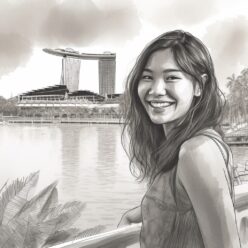Singapore’s “Chope” culture, also known as seat reservation, is a unique phenomenon in Singaporean society. This culture mainly manifests in public places, especially in busy food centers, cafes, and shopping malls. To ensure a seat in crowded places, people often use personal items, such as tissue packs, napkins, umbrellas, or document bags, to reserve a seat in advance. These items are considered temporary seat markers, indicating that the seat has been reserved.
The word “Chope” originates from Singapore English (Singlish), which is a Singaporean dialect that mixes English, Malay, Chinese, and Tamil, among other languages. In Singapore, the word “Chope” has been given a special meaning, describing the act of reserving seats in public places. This term conveys the intention of the reservation behavior while reflecting Singapore’s multicultural characteristics.

Another theory is that the term may be related to Indian English. In India, a “chop” is a type of seal often used on documents to indicate approval or authentication. In Singapore’s seat reservation culture, using tissue packs, umbrellas, and other items as symbols of reservation can be seen as an act similar to “sealing,” indicating that the seat has been authenticated or approved for someone’s exclusive use. This may be the connection between the word “Chope” and seat reservation behavior.
Regardless of the exact origin of the word “Chope,” it has become a widely accepted term in Singapore, used to describe the act of reserving seats in public places. The seat reservation culture is widely accepted in Singapore, not only because people respect rules and order, but also because it reflects the integration of Singapore’s diverse cultures to some extent.
Seat reservation culture is widely accepted and followed in Singapore. There are deep social and cultural reasons behind this phenomenon. Firstly, Singapore is a densely populated city-state with limited public space. People adopt this method to ensure a comfortable dining space in a crowded environment.
Secondly, Singaporeans highly respect rules and order. Therefore, although seat reservation culture may be considered impolite in other countries, it is seen as an effective way of resource allocation in Singapore. Seat reservation culture also reflects the “kiasu” mentality in Singaporean society, meaning “fear of losing” or “not wanting to lose to others,” as people want to ensure they do not fall behind others in finding a seat.
However, seat reservation culture has also sparked some controversy. Some people believe this practice is unfair, as it can put those who have already obtained food but cannot find a seat in an awkward situation. Additionally, some people worry that reservation behavior may lead to resource waste, as items used to reserve other seats may be abandoned once an ideal seat is found.
Overall, Singapore’s seat reservation culture is an interesting social phenomenon that reflects local people’s coping strategies when faced with limited resources. Although this practice may cause controversy, it is widely accepted and followed in Singapore.
